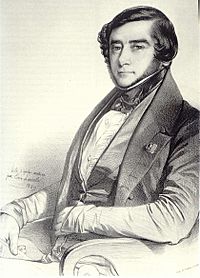Alcide d'Orbigny facts for kids
Quick facts for kids
Alcide Charles Victor Marie Dessalines d'Orbigny
|
|
|---|---|
 |
|
| Born | 6 September 1802 Couëron, France
|
| Died | 30 June 1857 (aged 54) |
| Nationality | French |
| Known for | malacology, fossils, palaeontology |
| Scientific career | |
| Fields | Natural history |
| Institutions | Muséum National d'Histoire Naturelle |
Alcide Charles Victor Marie Dessalines d'Orbigny (born September 6, 1802 – died June 30, 1857) was a French naturalist. He made big discoveries in many fields. These included studying animals (called zoology), ancient life forms (called palaeontology), rocks (called geology), old human history (called archaeology), and human cultures (called anthropology).
D'Orbigny was born in Couëron, France. His father was a ship's doctor and also loved nature. In 1820, his family moved to La Rochelle. There, Alcide became very interested in nature. He studied sea creatures, especially tiny ones he called "foraminiferans."
Later, in Paris, he became a student of famous scientists. These included Pierre Louis Antoine Cordier, a geologist, and Georges Cuvier. D'Orbigny always followed Cuvier's ideas about how life changed. He did not agree with Lamarckism, another theory of evolution at the time.
Contents
Journey to South America
D'Orbigny went on an important trip for the Paris Museum. He traveled through South America from 1826 to 1833. He visited many countries, including Venezuela, Colombia, Ecuador, Peru, Bolivia, Chile, Argentina, Paraguay, and Brazil.
He brought back a huge collection of over 10,000 natural history items. He wrote about some of his discoveries in a large book. It was called La Relation du Voyage dans l'Amérique Méridionale pendant les annés 1826 à 1833. Other scientists at the museum described the rest of his collection.
Charles Darwin, another famous naturalist, arrived in South America in 1832. When Darwin heard that d'Orbigny had already been there, he joked that d'Orbigny had probably found "the best of everything." Darwin later called d'Orbigny's travel book a "most important work." They even wrote letters to each other. D'Orbigny helped describe some of Darwin's own specimens.
In 1834, d'Orbigny received the Gold Medal from a geography society in Paris. An ancient mammal from South America, the Alcidedorbignya, was named in his honor.
Later Discoveries and Teaching
In 1840, d'Orbigny began to carefully describe French fossils. He published a big work called La Paléontologie Française (8 volumes). In 1849, he published another related book. It was called Prodrome de Paléontologie Stratigraphique. In this book, he described almost 18,000 species. He also set up geological stages, which are like time periods for Earth's history. These stages are still used today.
In 1853, he became a professor of palaeontology at the Paris Muséum National d'Histoire Naturelle. This special teaching position was created just for him. He wrote a book called Cours élémentaire. It showed how paleontology was connected to zoology. He believed it was its own science, separate from how it was used to study rock layers.
D'Orbigny described many geological time periods. Many of these are still used today. Some examples are Toarcian, Callovian, Oxfordian, Kimmeridgian, Aptian, Albian, and Cenomanian. He passed away in Pierrefitte-sur-Seine, a small town near Paris.
Ideas on Earth's History
D'Orbigny was a strong believer in catastrophism. This idea suggests that Earth's history was shaped by sudden, powerful events.
He thought that the fossil record showed twenty-seven major events. Each event, he believed, wiped out all life on Earth. Then, new life forms were created. This idea was called the "doctrine of successive creations."
Animals and Plants Named After Him
Many animals and plants have been named in honor of Alcide d'Orbigny. Here are some examples:
- Alcidedorbignya Muizon & Marshall, 1992 – an extinct mammal
- Alcidia Bourguignat, 1889 – a type of sea snail
- Ampullaria dorbignyana Philippi, 1851 – a type of freshwater snail
- Apostolepis dorbignyi Schlegel, 1837 – a type of burrowing snake
- Asthenes dorbignyi Reichenbach, 1853 - a type of bird
- Bachia dorbignyi A.M.C. Duméril & Bibron, 1839 – a type of lizard
- Cadomites orbignyi de Grossouvre, 1930 – a type of ammonite (an extinct sea creature)
- Chaunus dorbignyi (A.M.C. Duméril & Bibron, 1841) – a type of toad
- Haminoea orbignyana A. de Férussac, 1822 – a type of sea snail
- Hecticoceras (Orbignyceras) C. Gérard & H. Contaut, 1936 – a type of ammonite
- Liolaemus dorbignyi Koslowsky, 1898 – a type of lizard
- Lystrophis dorbignyi A.M.C. Duméril, Bibron & A.H.A. Duméril, 1854 – a type of snake
- Nerocila orbignyi (Guérin, 1832) – a type of parasitic isopod
- Orbignya Mart. ex Endl. – a type of palm tree, including the Brazilian palm tree
- Pinna dorbignyi Hanley, 1858 – a type of bivalve mollusc
- Quadracythere orbignyana (Bosquet, 1852) – a type of marine ostracod
- Rhinodoras dorbignyi (Kner, 1855) – a type of thorny catfish
- Sepia (Rhombosepion) orbignyana A. de Férussac in d'Orbigny, 1826 – a type of cuttlefish, known as the pink cuttlefish
- Subdiscosphinctes orbignyi Hantzpergue, 1987 – a type of ammonite
- Trachemys dorbigni (A.M.C. Duméril & Bibron, 1835) – a type of freshwater turtle
When you see a name in parentheses after a species, it means that species was first described in a different group (genus) than the one it's in now.
Images for kids
See also
 In Spanish: Alcide d'Orbigny para niños
In Spanish: Alcide d'Orbigny para niños


